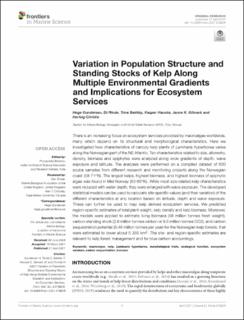| dc.contributor.author | Gundersen, Hege | |
| dc.contributor.author | Rinde, Eli | |
| dc.contributor.author | Bekkby, Trine | |
| dc.contributor.author | Hancke, Kasper | |
| dc.contributor.author | Gitmark, Janne K | |
| dc.contributor.author | Christie, Hartvig | |
| dc.date.accessioned | 2021-07-23T07:35:06Z | |
| dc.date.available | 2021-07-23T07:35:06Z | |
| dc.date.created | 2021-06-24T15:23:40Z | |
| dc.date.issued | 2021 | |
| dc.identifier.citation | Frontiers in Marine Science. 2021, 8, 578629. | en_US |
| dc.identifier.issn | 2296-7745 | |
| dc.identifier.uri | https://hdl.handle.net/11250/2765159 | |
| dc.description.abstract | There is an increasing focus on ecosystem services provided by macroalgae worldwide, many which depend on its structural and morphological characteristics. Here we investigated how characteristics of canopy kelp plants of Laminaria hyperborea varies along the Norwegian part of the NE Atlantic. Ten characteristics related to size, allometry, density, biomass and epiphytes were analyzed along wide gradients of depth, wave exposure and latitude. The analyses were performed on a compiled dataset of 630 scuba samples from different research and monitoring projects along the Norwegian coast (58-71◦N). The largest kelps, highest biomass, and highest biomass of epiphytic algae was found in Mid-Norway (63-65◦N). While most size-related kelp characteristics were reduced with water depth, they were enlarged with wave exposure. The developed statistical models can be used to calculate site-specific values (and their variation) of the different characteristics at any location based on latitude, depth and wave exposure. These can further be used to map kelp derived ecosystem services. We predicted region-specific estimates of total plant weight, kelp density and kelp biomass. Moreover, the models were applied to estimate living biomass (56 million tonnes fresh weight), carbon standing stock (2.6 million tonnes carbon or 9.5 million tonnes CO2), and carbon sequestration potential (0.46 million tonnes per year) for the Norwegian kelp forests, that were estimated to cover about 5 355 km2. The site- and region-specific estimates are relevant to kelp forest management and for blue carbon accountings. | en_US |
| dc.language.iso | eng | en_US |
| dc.publisher | Frontiers | en_US |
| dc.relation.uri | https://www.frontiersin.org/articles/10.3389/fmars.2021.578629/full | |
| dc.rights | Navngivelse 4.0 Internasjonal | * |
| dc.rights.uri | http://creativecommons.org/licenses/by/4.0/deed.no | * |
| dc.title | Variation in population structure and standing stocks of kelp along multiple environmental gradients and implications for ecosystem services | en_US |
| dc.type | Peer reviewed | en_US |
| dc.type | Journal article | en_US |
| dc.description.version | publishedVersion | en_US |
| dc.rights.holder | Copyright © 2021 Gundersen, Rinde, Bekkby, Hancke, Gitmark and Christie. | en_US |
| dc.source.pagenumber | 19 | en_US |
| dc.source.volume | 8 | en_US |
| dc.source.journal | Frontiers in Marine Science | en_US |
| dc.identifier.doi | 10.3389/fmars.2021.578629 | |
| dc.identifier.cristin | 1918217 | |
| dc.relation.project | Norges forskningsråd: 184638 | en_US |
| dc.relation.project | Norges forskningsråd: 280778 | en_US |
| dc.relation.project | Norges forskningsråd: 280732 | en_US |
| dc.relation.project | Norges forskningsråd: 267536 | en_US |
| dc.relation.project | EC/H2020/869192 | en_US |
| dc.source.articlenumber | 578629 | en_US |
| cristin.ispublished | true | |
| cristin.fulltext | original | |
| cristin.qualitycode | 1 | |

